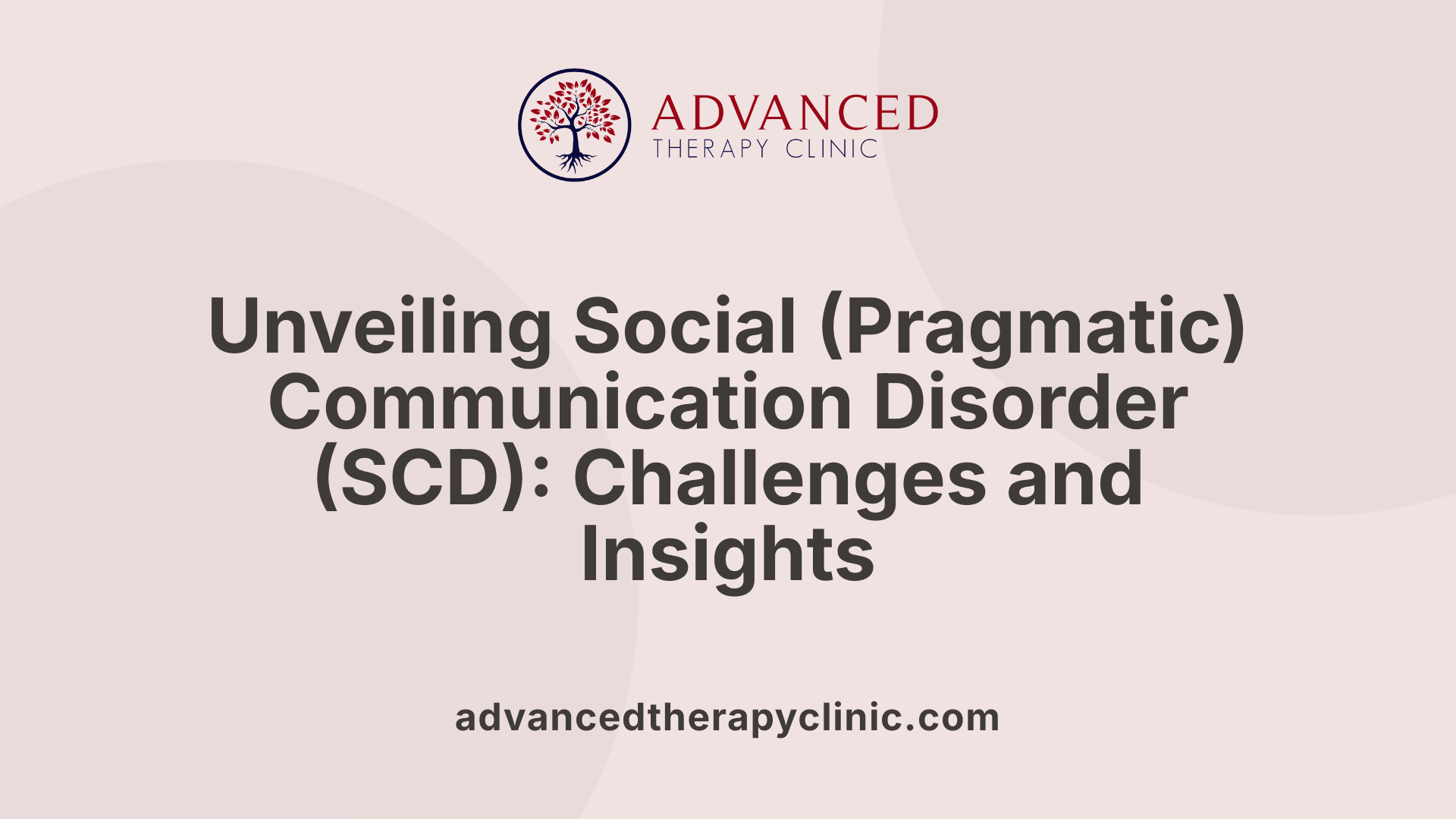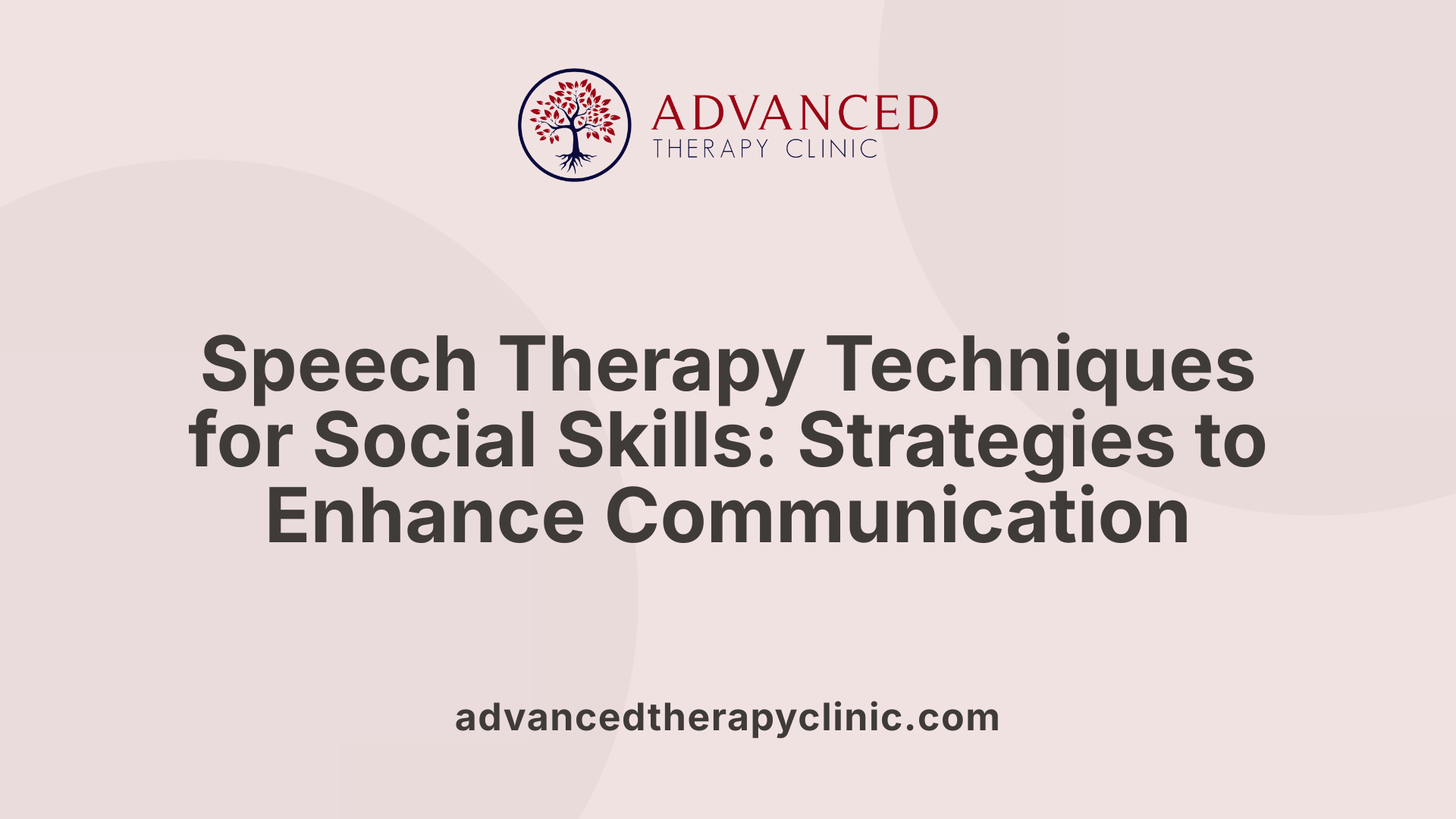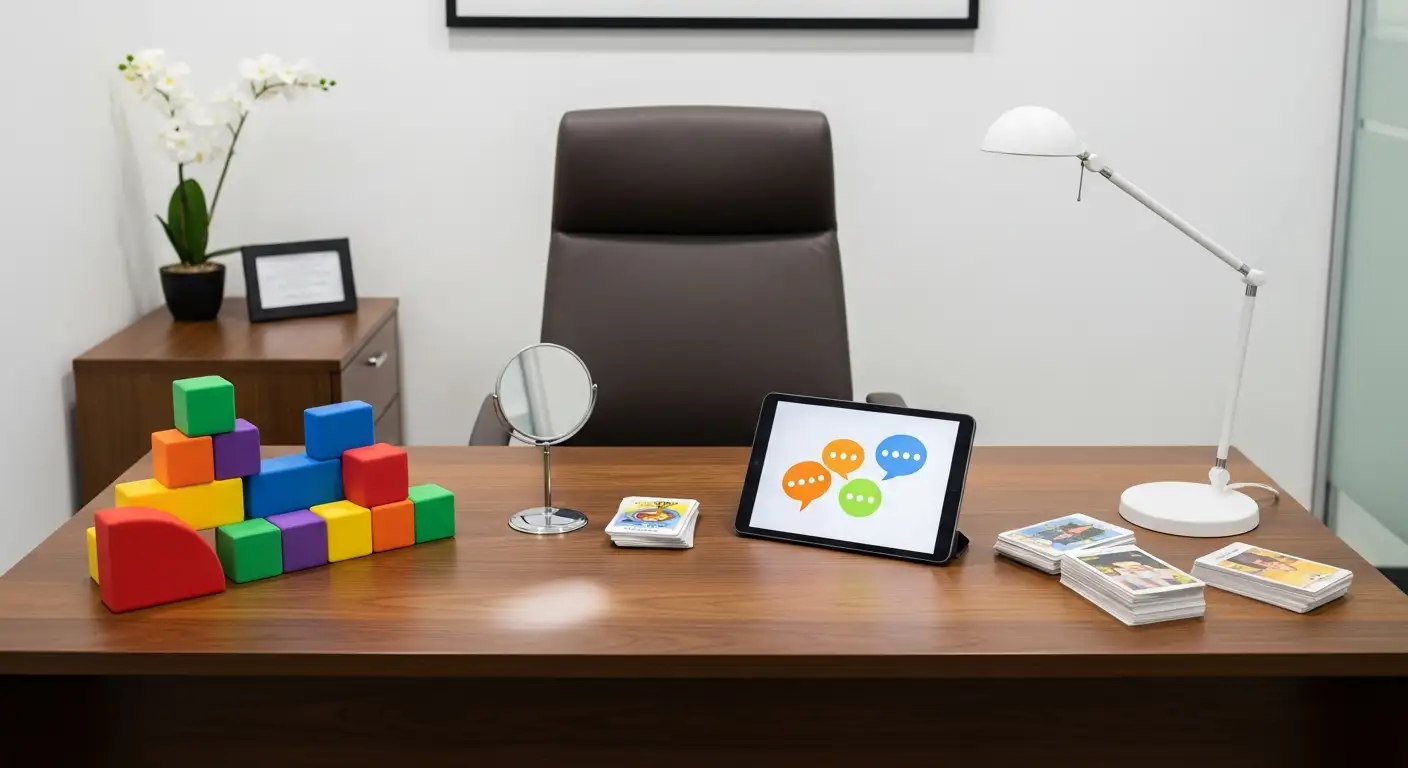How Speech Therapy Helps Children with Social Communication Deficits


Understanding the Power of Speech Therapy in Social Development
Social communication skills are fundamental for building relationships, participating in community life, and achieving personal and academic success. Children with social communication deficits, often diagnosed with Social Communication Disorder (SCD) or autism spectrum disorder (ASD), face challenges in understanding social cues, initiating and maintaining conversations, and interpreting nonverbal signals. Speech therapy plays a crucial role in addressing these difficulties through tailored, evidence-based interventions designed to foster effective social interaction and communication.
What Is Social Communication and Its Significance

What is social communication?
Social communication revolves around the way we use verbal and nonverbal skills to engage with others effectively in society. It encompasses more than just talking; it involves interpreting social cues, adjusting language to suit different situations, and adhering to social norms, whether explicit or implicit. This form of communication is essential for building relationships, cooperating with others, and functioning well in social environments.
Components involved in social communication
Understanding social communication requires recognizing its multiple components:
- Social Interaction: Engaging in conversations, sharing ideas, and responding appropriately.
- Social Cognition: Recognizing and interpreting others’ emotions, intentions, and social cues.
- Pragmatics: Using language appropriately for different purposes, like greeting, informing, requesting, or storytelling.
- Language Processing: Comprehending and producing language suited to the social context.
These elements help individuals navigate social settings, develop friendships, and succeed academically or professionally. Challenges in any of these areas, such as difficulty understanding nonverbal cues or staying on topic, can hinder effective communication.
Why is social communication important?
Social communication is vital across all ages and settings. It allows individuals to share emotions, understand others, and engage in meaningful interactions. Difficulties here can lead to social isolation, misunderstandings, or behavioral issues.
Interventions, often led by speech-language pathologists, focus on teaching skills like interpreting facial expressions, initiating conversations, and understanding the social rules of dialogue. Building these abilities helps improve confidence, independence, and overall well-being.
Understanding Social (Pragmatic) Communication Disorder (SCD)

What is social communication disorder?
Social communication disorder (SCD) is a neurodevelopmental condition marked by ongoing difficulties in using verbal and nonverbal communication effectively for social purposes. Individuals with SCD find it challenging to understand and interpret social cues, such as gestures, facial expressions, and tone of voice. They may also struggle to adapt their language to different social situations, tell stories, or maintain appropriate conversations. These challenges can affect their ability to develop and sustain friendships, perform well in school, and participate fully in social activities.
Unlike autism spectrum disorder, SCD does not involve restricted or repetitive behaviors, distinguishing it as a specific condition focused on pragmatic language skills. The causes of SCD are not fully understood, but it often coexists with other developmental issues, such as language impairments or learning disabilities. Early identification and targeted speech therapy can help improve communication abilities and social understanding.
Symptoms and diagnosis
Signs of SCD include difficulty initiating and maintaining conversations, trouble understanding nonliteral language like sarcasm or idioms, and problems with social reciprocity such as responding to greetings or sharing emotions appropriately. Children with SCD may also struggle with eye contact, understanding gestures, and adjusting their speech based on the listener or setting.
Diagnosis involves comprehensive assessment by a speech-language pathologist using standardized tests and informal observations. Professionals evaluate both verbal and nonverbal skills, social interactions, and pragmatic language abilities. It is crucial to differentiate SCD from other conditions like ASD, which involves additional features such as repetitive behaviors and restricted interests.
Difference between SCD and autism
While both SCD and autism spectrum disorder involve social communication challenges, they have distinct characteristics. In autism, social difficulties are paired with restricted interests, repetitive behaviors, and sensory sensitivities. SCD, on the other hand, centers solely on pragmatic language issues—how language is used in social contexts—without the presence of repetitive behaviors.
Effective diagnosis requires careful evaluation to ensure appropriate intervention. SLPs use a combination of formal testing, observation, and information from caregivers and teachers to determine if a child meets the criteria for SCD or ASD.
Why understanding SCD matters
Recognizing and addressing SCD early can prevent social isolation, improve peer relationships, and enhance academic and social success. Speech therapy tailored to pragmatic language goals can teach individuals strategies for social reasoning, understanding social rules, and using language effectively in diverse situations.
| Aspect | Details | Additional Notes |
|---|---|---|
| Main Challenges | Social cues, nonliteral language, conversation maintenance | Includes understanding emotions and intentions |
| Assessment Tools | Standardized pragmatic language tests, observation | Used by licensed speech therapists |
| Intervention Methods | Role-playing, social stories, video modeling | Focuses on real-world practice |
| Differences from Autism | No restricted/repetitive behaviors, focus on pragmatics | Diagnostic criteria in DSM-5 |
| Impact | Social participation, academic performance, mental health | Supports better life quality |
Understanding SCD enables caregivers, educators, and clinicians to provide the necessary support for individuals struggling with social communication. Tailored interventions foster social participation and help build meaningful relationships, supporting overall well-being.
Techniques and Methods Used in Speech Therapy for Social Skills
 Speech therapy for social communication challenges utilizes a broad set of techniques to help individuals improve their interaction skills. These methods aim to develop both verbal and nonverbal communication, including understanding social cues, taking turns in conversation, and adjusting language to fit social contexts.
Speech therapy for social communication challenges utilizes a broad set of techniques to help individuals improve their interaction skills. These methods aim to develop both verbal and nonverbal communication, including understanding social cues, taking turns in conversation, and adjusting language to fit social contexts.
One common method is the use of social stories. These are short, illustrated narratives that teach specific social behaviors in various situations, helping children understand what is expected of them.
Role-playing is another highly effective strategy. In therapy sessions, individuals practice real-life social interactions by acting out scenarios, which allows them to rehearse responses and behaviors in a safe environment. This helps build confidence and reinforces social rules.
Video modeling involves showing individuals videos of peers or adults demonstrating appropriate social behaviors. Watching these videos helps learners understand social norms and cues, providing visual examples to imitate.
Visual supports, such as picture cards, gestures, and visual schedules, aid those who learn better through visual cues. These tools help individuals recognize nonverbal signals, manage transitions, and follow social routines.
Therapists often combine these techniques with pragmatic language exercises that focus on using language effectively for different purposes—such as greeting, informing, requesting, or expressing emotions—and tailoring communication based on the listener and situation.
In addition to structured activities, strategies like perspective-taking, understanding idioms or humor, and practicing body language and eye contact are integrated into therapy sessions.
Interventions are personalized according to each individual's age, cognitive level, and specific social communication needs. The use of direct instruction, feedback, and real-world practice helps ensure skills learned in therapy carry over to everyday life.
Furthermore, innovative resources like social skills groups, digital apps, and social skills training programs are incorporated to motivate individuals and provide additional practice outside of therapy sessions.
Collaboration with family members, teachers, and other professionals enhances the effectiveness of therapy by reinforcing positive behaviors across different environments and ensuring consistent support.
Overall, these techniques work synergistically to improve core social communication skills, enabling individuals to better understand social rules, interpret cues, and engage more effectively in social interactions.
Benefits and Outcomes of Speech Therapy in Social Skills Development

What are the benefits and expected outcomes of speech therapy on social interaction and communication?
Speech therapy provides significant advantages in improving both verbal and nonverbal aspects of social interaction. Children and adults participating in therapy learn to understand and interpret social cues such as facial expressions, gestures, tone of voice, and humor, which are crucial for effective communication.
One of the main goals is to enhance pragmatic language skills—these include using language appropriately for different contexts, such as greeting others, making requests, and maintaining conversations. Therapists often use engaging methods like role-playing, video modeling, and scripted conversations to help individuals internalize these skills.
As a result, individuals often experience increased confidence in social settings. This boost in self-assurance encourages more active participation in social, academic, and workplace environments. Additionally, speech therapy teaches practical skills like turn-taking, staying on topic, and interpreting nonverbal signals, which are foundational for forming and sustaining meaningful relationships.
Beyond immediate improvements in speech clarity and vocabulary, therapy also helps to reduce behaviors associated with frustration or anxiety stemming from communication difficulties. This can include fewer meltdowns or aggressive responses during social interactions.
Ultimately, the benefits extend to broader life outcomes. People become better equipped to navigate social situations, foster friendships, and succeed in both educational and professional settings. Over time, these skills promote social inclusion, emotional well-being, and independence.
By developing comprehensive communication skills, individuals are more likely to engage confidently with others, leading to improved social participation and a richer quality of life.
The Role of Speech-Language Pathologists and Collaborative Strategies

How do speech-language pathologists support children with social communication challenges?
Speech-language pathologists (SLPs) are central to helping children improve their social communication skills. They start by conducting thorough assessments to identify specific difficulties in pragmatic language, including understanding social cues, using gestures, and following conversational rules.
Based on these evaluations, SLPs develop personalized treatment plans tailored to each child's unique needs. These plans often include teaching children how to use speech and non-verbal cues effectively, such as making eye contact, interpreting facial expressions, and adjusting language based on the social context.
Interventions incorporate various engaging methods like role-playing, modeling social interactions, and using visual aids or comic strip conversations. These strategies help children practice real-life situations safely and confidently.
SLPs also focus on improving pragmatic skills such as turn-taking, perspective-taking, understanding humor or sarcasm, and maintaining topics during conversations. They work across different settings—home, school, or therapy groups—to make skills generalize to everyday life.
Furthermore, SLPs collaborate with families, teachers, and other professionals to create consistent support systems. They provide caregivers and educators with practical strategies, like using social stories or video modeling, to reinforce social skills in natural environments.
By combining assessment, individualized therapy, group work, and family involvement, speech-language pathologists play a vital role in empowering children to communicate effectively, make friends, and participate fully in social activities. Their work significantly enhances social confidence and overall quality of life for children facing social communication difficulties.
Early Intervention Strategies and the Importance of Assessment
What are effective early intervention strategies for social communication disorders?
Early intervention plays a crucial role in supporting children with social communication disorders, aiming to improve their social skills, language use, and overall social adaptability. Several approaches have proven effective.
Parent-mediated programs, such as the Preschool Autism Communication Trial (PACT) and the Behavior Interventional Support for Communication (BISC), focus on empowering parents to support their child's social development. These programs teach parents how to facilitate social initiations, joint attention, and reciprocal interactions through mediated learning practices. By involving caregivers actively, these strategies help children practice social skills in everyday environments.
Clinician-led interventions also contribute significantly. Techniques like social stories, which are short narratives designed to teach specific social behaviors, and video modeling, where children watch videos demonstrating desired behaviors, are used to improve understanding and imitation of social skills. Social skills curricula often include role-playing and structured activities that target pragmatic language, turn-taking, and nonverbal cues.
Delivering these interventions in natural settings such as home and school enhances skill transfer to real-world situations. Tailoring programs to each child's unique social-communication deficits ensures more effective outcomes.
Early, family-empowering strategies are especially valuable during preschool years, around ages 3 to 4. These interventions can lead to long-term benefits, including reduced autism symptoms and enhanced social competence. Continual assessment through observation and standardized tools helps clinicians monitor progress, adjust treatment goals, and ensure meaningful development.
Ultimately, combining parent involvement with targeted clinician-led therapy fosters a supportive environment where children can develop essential social communication skills that impact their daily lives and future relationships.
Assessment and Diagnosis of Social Communication Difficulties
How are social communication difficulties assessed and diagnosed in children?
Evaluating social communication challenges in children involves a mix of observation, formal testing, and input from caregivers. Speech-language pathologists (SLPs) typically use a variety of tools to gather comprehensive information about a child's pragmatic skills and social understanding.
Observation plays a crucial role. Clinicians observe children during structured tasks and natural interactions to assess skills like eye contact, turn-taking, joint attention, recognizing nonverbal cues, and emotional understanding. These observations help identify if the child's social behaviors differ from typical developmental patterns.
Standardized tests are also employed. These assessments are designed to measure pragmatic language abilities and social cognition, often involving age-appropriate activities and rating scales. For instance, tools like the IMPACT Social Communication Rating Scale (ISCRS) and the Autism Spectrum Screening Questionnaire (ASSQ) are used to quantify social communication abilities.
Alongside formal assessments, informal tools such as social stories, role-playing, and caregiver interviews assist in understanding how children communicate in everyday contexts. Questionnaires and interviews taken from parents, teachers, or caregivers provide valuable insights into the child's social interactions across different settings.
It's important to consider cultural and environmental factors during assessment. Different cultural norms influence social behaviors, and what is deemed typical in one culture may differ in another. Clinicians must interpret behaviors within the appropriate social and cultural context to avoid misdiagnosis.
The diagnostic process involves comparing a child's performance against established criteria. According to the DSM-5, diagnosing social communication disorder (SCD) requires persistent difficulties in social use of verbal and nonverbal communication across multiple settings, leading to significant functional limitations in social, academic, or occupational areas.
This comprehensive approach ensures accurate identification of social communication difficulties, guiding targeted intervention strategies. Continuous monitoring through follow-up assessments helps track progress and adapt therapy goals accordingly.
Empowering Children for Confident Social Engagement
In summary, speech therapy provides essential tools and strategies to support children with social communication deficits, helping them develop the skills necessary for meaningful social interactions and relationships. Early assessment, individualized treatment plans, and collaboration among professionals, families, and educators are critical for successful outcomes. As children learn to interpret social cues, use language effectively, and navigate social norms, they gain confidence and independence, enhancing their overall quality of life and integration into their communities. Continued research and innovation in speech therapy approaches promise even greater support for children facing social communication challenges, ensuring they are equipped to participate fully in everyday social life.
References
- How Speech Therapy Can Help Children and Adults with Their ...
- Understanding Social Communication Disorder: How it Differs from ...
- Social Communication - ASHA
- How Speech Therapy Enhances Social Skills In Children
- The Benefits of Speech Therapy for Children with Autism
- Building Blocks of Communication: How Speech Therapy Helps Kids
- Speech Language Therapy and Selective Mutism - SMA
- How Speech Therapy Can Improve Social Communication Disorders
- Social Skills Therapy for Kids: How to Teach Social Communication ...
Recent articles

What Is Speech Fluency?
Understanding the Essentials of Speech Fluency and Its Disorders

What Is Speech Fluency?
Understanding the Essentials of Speech Fluency and Its Disorders

Teaching Writing to Students with Autism
Unlocking the Potential: Effective Writing Instruction for Students with Autism

Teaching Writing to Students with Autism
Unlocking the Potential: Effective Writing Instruction for Students with Autism

Speech Therapist School
Navigating the Path to a Rewarding Career in Speech Therapy

Pediatric Speech Therapy Programs
Unlocking Potential Early: The Role of Speech Therapy in Pediatric Development

